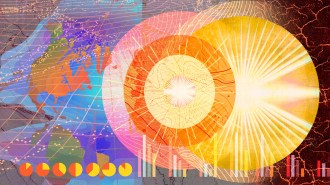Virtual twister reveals possible source of tornado longevity
Storm simulation suggests rain keeps tornadoes spinning

CYBER STORM The 60-kilometer-wide swirling thunderstorm in this simulation spawned the first digitally created long-lived EF5 tornado (bottom, right-center). The 700-meter-wide virtual twister may reveal why some real-life tornadoes linger.
David Bock






